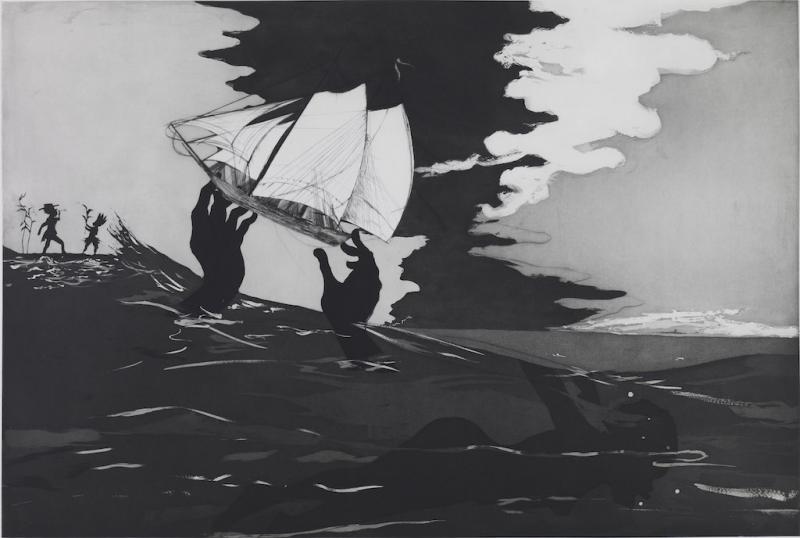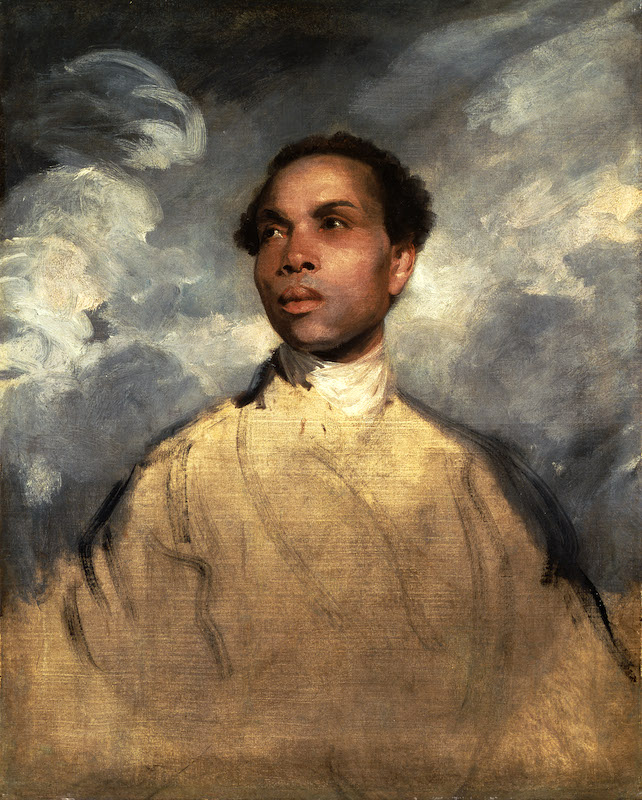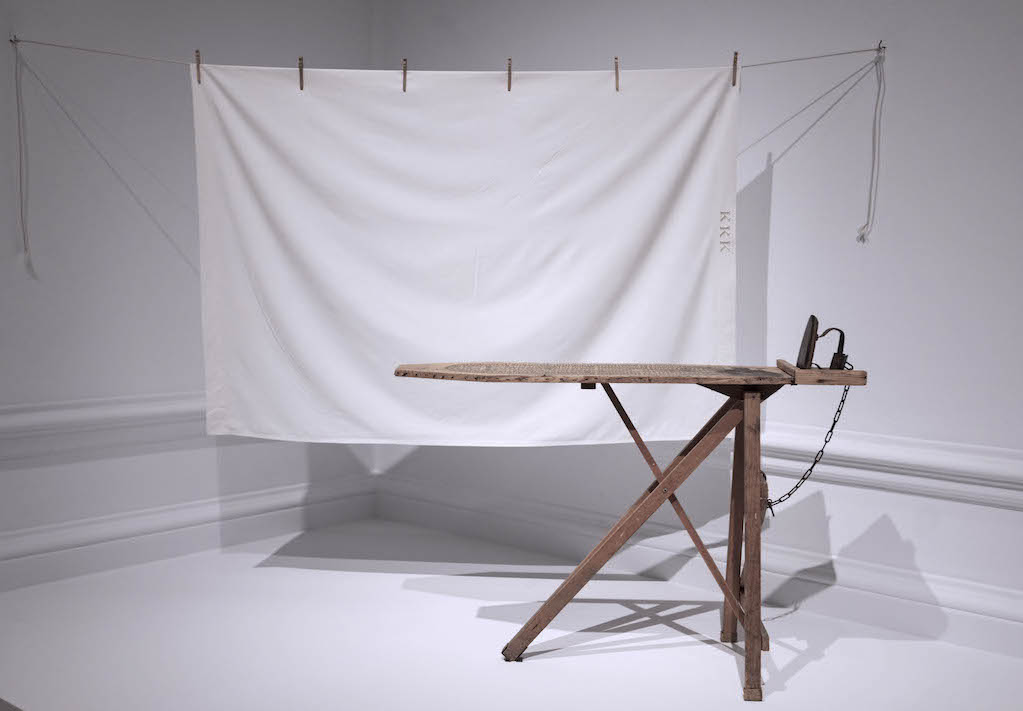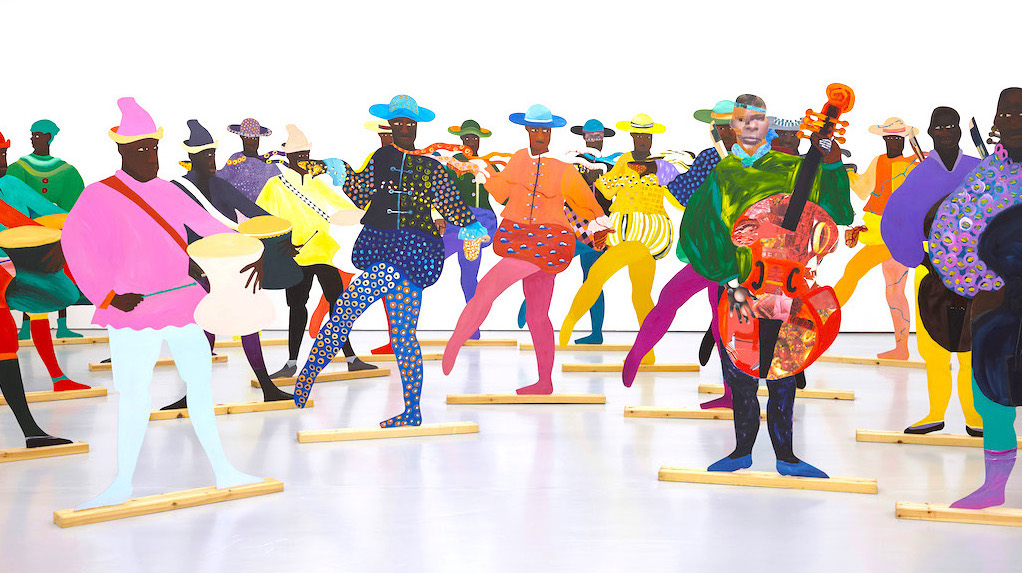Entangled Pasts 1768-now, Royal Academy review - an institution exploring its racist past | reviews, news & interviews
Entangled Pasts 1768-now, Royal Academy review - an institution exploring its racist past
Entangled Pasts 1768-now, Royal Academy review - an institution exploring its racist past
After a long, slow journey from invisibility to agency, black people finally get a look in

In Titian’s painting Diana and Actaeon,1559, a cluster of naked beauties bathes beside a stream. Scarcely visible in the right hand corner is a black woman helping the goddess hide her nudity from Acteon who has stumbled into her private glade. The servant’s clothing and dark skin contrast with the pearly pink flesh of the nymphs – so much so that she almost merges with the tree trunk behind her, as though she were just part of the scenery.
In her intaglio version of Titian’s painting, Barbara Walker bleaches out everyone except the black woman, whom she lovingly highlights in pencil. This reclamation is like a template for the Royal Academy’s Entangled Pasts 1768-now, whose aim is to shift black people from background to foreground – from the menial position of servants and slaves, which they’ve occupied for centuries, to centre stage as individuals worthy of note.
The slave trade was in full swing when the Royal Academy was established in 1768, abolition being 40 years in the future. And the subservient roles allotted to black people is reflected in a painting by Joshua Reynolds, first President of the RA. His portrait of George Prince of Wales, 1787, features a black servant adjusting the clothing of the future king. It caused a furore at the time, ironically because of the proximity of the black man to the white prince.
 Yet there were exceptions. In his Portrait of a Man,1770, (pictured right), Reynolds confers enormous dignity on his sitter even though he doesn’t honour him with a name. And in 1816, Richard Evans painted Henri Christophe, leader of post-revolutionary Haiti, in the grand manner of a royal portrait. John Singleton Copley was the only Academician actually to own slaves and the man who posed for him in 1778 might well have been one of them yet, paradoxically, Copley portrays him as a spirited individual.
Yet there were exceptions. In his Portrait of a Man,1770, (pictured right), Reynolds confers enormous dignity on his sitter even though he doesn’t honour him with a name. And in 1816, Richard Evans painted Henri Christophe, leader of post-revolutionary Haiti, in the grand manner of a royal portrait. John Singleton Copley was the only Academician actually to own slaves and the man who posed for him in 1778 might well have been one of them yet, paradoxically, Copley portrays him as a spirited individual.
The exhibition takes the form of a dialogue between past and present, in which contemporary black and coloured artists respond to historical racism. Indiennes: The Extended Triangle, 2018, (from the series The Slaves of Fashion) by the Singh Twins is like an exquisite Indian miniature writ large. It features Fanny Eaton, a mixed race model whose beauty made her a favourite with the Pre-Raphaelites. Here she is dressed in Indian fabrics that were once traded for African slaves in the port of Nantes in France. She brandishes a gun and surrounding her are reminders of the ubiquity of the trade in people and goods and the many fortunes made from it.
An especially powerful juxtaposition is Kara Walker’s wonderful etching no worlds, 2010, (main picture) with a print based on Thomas Stothard’s sickening painting of The Voyage of the Sable Venus from Angola to the West Indies, 1794. Like Botticelli’s Venus, his black nude rides the waves on a conch shell pulled by dolphins, watched by Neptune who waves a union jack. Like Ron de Santis, the Republican apologist for slavery, Stothard portrays the Middle Passage as an opportunity. Walker, on the other hand, honours those transported across the Atlantic with black hands that hold aloft a slave ship while a woman drowns in the depths beneath – a reference to the practice of throwing pregnant women overboard.
Isaac Julien’s 2019 film about the tour of Britain made by abolitionist Frederick Douglass in 1845, that was shown in his Tate Britain exhibition, is paired with titillating statues of female nudes decked with chains that are more like accessories than manacles. Oddly, Douglass owned one of these – a pure white porcelain Venus by Hiram Power tilted The Greek Slave. Betye Saar’s installation I’ll Bend But I Will Not Break, I998 (pictured above) is a reminder that the legacy of slavery still lives on today. Burned into the surface of an old ironing board is a diagram showing how 454 slaves were packed into the hold of Brookes, a British slave ship. Shackled to the board is an old iron and pegged onto the nearby washing line is the Ku Klux Klan garment the black woman has just finished ironing. It hangs there like an ominous shroud, continually making its presence felt.
Betye Saar’s installation I’ll Bend But I Will Not Break, I998 (pictured above) is a reminder that the legacy of slavery still lives on today. Burned into the surface of an old ironing board is a diagram showing how 454 slaves were packed into the hold of Brookes, a British slave ship. Shackled to the board is an old iron and pegged onto the nearby washing line is the Ku Klux Klan garment the black woman has just finished ironing. It hangs there like an ominous shroud, continually making its presence felt.
Dominating the main gallery is John Akomfrah’s three screen epic Vertigo Sea, 2015. Glorious footage from wild life films establishes the awesome majesty of the elements and the creatures living in and around the oceans. Archive footage of fishing, whaling, seal and polar bear hunting, of oil rigs and atom bomb tests record our destructive interactions with the deep, while film of Vietnamese boat people and recreations of slave ships reflect our use of the sea as a highway. It’s an apocalyptic vision that encourages despair at the cruelty and stupidity of the human race, a feeling that is reinforced by room after room of images imbued with racist ideology.
Entangled Pasts, 1768-now is a brave attempt by an institution to acknowledge its past and redress the balance; inevitably, though, the weight of history swamps the contemporary voices raised in opposition, no matter how eloquent they are. It may be an apt reflection of how entrenched racist views were in our culture and how far there is still to go, but this does little to ameliorate the depressing effect of this mea culpa exercise. The saving grace comes in the last two rooms, which celebrate Lubaina Himid’s Naming the Money, 2004, (pictured above) with the best installation I’ve seen of her glorious cut-outs. The carnival of colourful figures is accompanied by a soundtrack in which each person speaks his or her name followed by a brief synopsis of their fate. “My name is Gulu. They call me Harry. I used to play for my family. Now I play for theirs. But I have my songs.” The stories are of loss of identity through enslavement, yet the message remains resolutely upbeat, since Himid honours the indomitable power of the human spirit and people’s refusal to be crushed by circumstances.
The saving grace comes in the last two rooms, which celebrate Lubaina Himid’s Naming the Money, 2004, (pictured above) with the best installation I’ve seen of her glorious cut-outs. The carnival of colourful figures is accompanied by a soundtrack in which each person speaks his or her name followed by a brief synopsis of their fate. “My name is Gulu. They call me Harry. I used to play for my family. Now I play for theirs. But I have my songs.” The stories are of loss of identity through enslavement, yet the message remains resolutely upbeat, since Himid honours the indomitable power of the human spirit and people’s refusal to be crushed by circumstances.
rating
Explore topics
Share this article
more Visual arts
 Eye to Eye: Homage to Ernst Scheidegger, MASI Lugano review - era-defining artist portraits
One of Switzerland's greatest photographers celebrated with a major retrospective
Eye to Eye: Homage to Ernst Scheidegger, MASI Lugano review - era-defining artist portraits
One of Switzerland's greatest photographers celebrated with a major retrospective
 Stephen review - a breathtakingly good first feature by a multi-media artist
Melanie Manchot's debut is strikingly intelligent and compelling
Stephen review - a breathtakingly good first feature by a multi-media artist
Melanie Manchot's debut is strikingly intelligent and compelling
 Fantastic Machine review - photography's story from one camera to 45 billion
Love it or hate it, the photographic image has ensnared us all
Fantastic Machine review - photography's story from one camera to 45 billion
Love it or hate it, the photographic image has ensnared us all
 Yinka Shonibare: Suspended States, Serpentine Gallery review - pure delight
Weighty subject matter treated with the lightest of touch
Yinka Shonibare: Suspended States, Serpentine Gallery review - pure delight
Weighty subject matter treated with the lightest of touch
 Jane Harris: Ellipse, Frac Nouvelle-Aquitaine MÉCA, Bordeaux review - ovals to the fore
Persistence and conviction in the works of the late English painter
Jane Harris: Ellipse, Frac Nouvelle-Aquitaine MÉCA, Bordeaux review - ovals to the fore
Persistence and conviction in the works of the late English painter
 Sargent and Fashion, Tate Britain review - portraiture as a performance
London’s elite posing dressed up to the nines
Sargent and Fashion, Tate Britain review - portraiture as a performance
London’s elite posing dressed up to the nines
 Zineb Sedira: Dreams Have No Titles, Whitechapel Gallery review - a disorientating mix of fact and fiction
An exhibition that begs the question 'What and where is home?'
Zineb Sedira: Dreams Have No Titles, Whitechapel Gallery review - a disorientating mix of fact and fiction
An exhibition that begs the question 'What and where is home?'
 Yoko Ono: Music of the Mind, Tate Modern review - a fitting celebration of the early years
Acknowledgement as a major avant garde artist comes at 90
Yoko Ono: Music of the Mind, Tate Modern review - a fitting celebration of the early years
Acknowledgement as a major avant garde artist comes at 90
 Unravel: The Power and Politics of Textiles in Art, Barbican review - the fabric of dissent
An ambitious exploration of a neglected medium
Unravel: The Power and Politics of Textiles in Art, Barbican review - the fabric of dissent
An ambitious exploration of a neglected medium
 When Forms Come Alive, Hayward Gallery review - how to reduce good art to family fun
Seriously good sculptures presented as little more than playthings or jokes
When Forms Come Alive, Hayward Gallery review - how to reduce good art to family fun
Seriously good sculptures presented as little more than playthings or jokes
 Entangled Pasts 1768-now, Royal Academy review - an institution exploring its racist past
After a long, slow journey from invisibility to agency, black people finally get a look in
Entangled Pasts 1768-now, Royal Academy review - an institution exploring its racist past
After a long, slow journey from invisibility to agency, black people finally get a look in
 Barbara Kruger, Serpentine Gallery review - clever, funny and chilling installations
Exploring the lies, deceptions and hyperbole used to cajole, bully and manipulate us
Barbara Kruger, Serpentine Gallery review - clever, funny and chilling installations
Exploring the lies, deceptions and hyperbole used to cajole, bully and manipulate us

Add comment